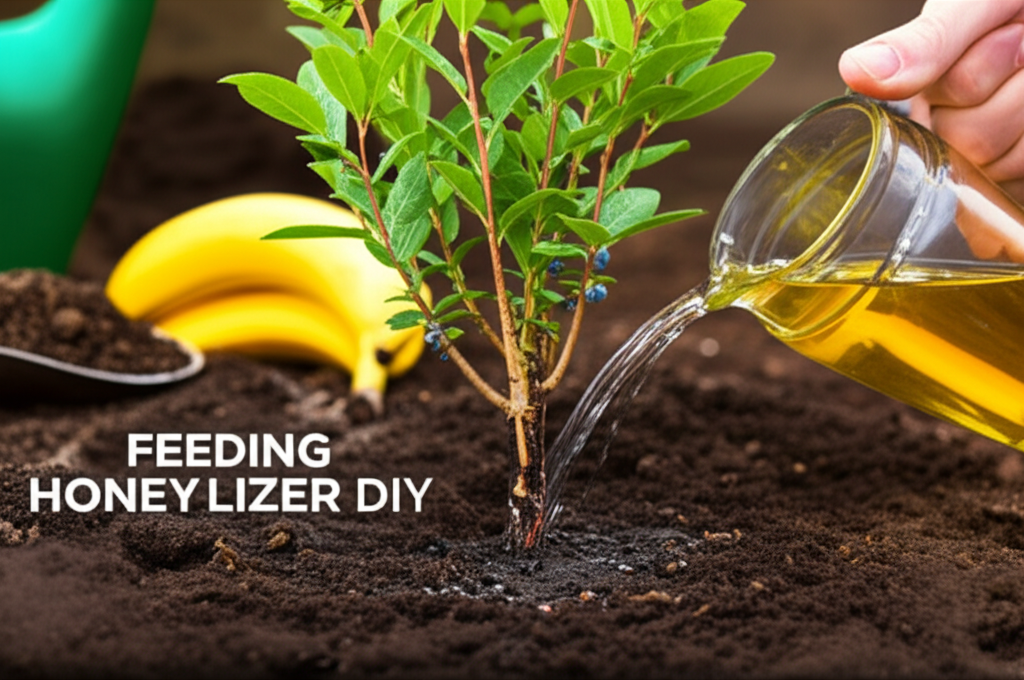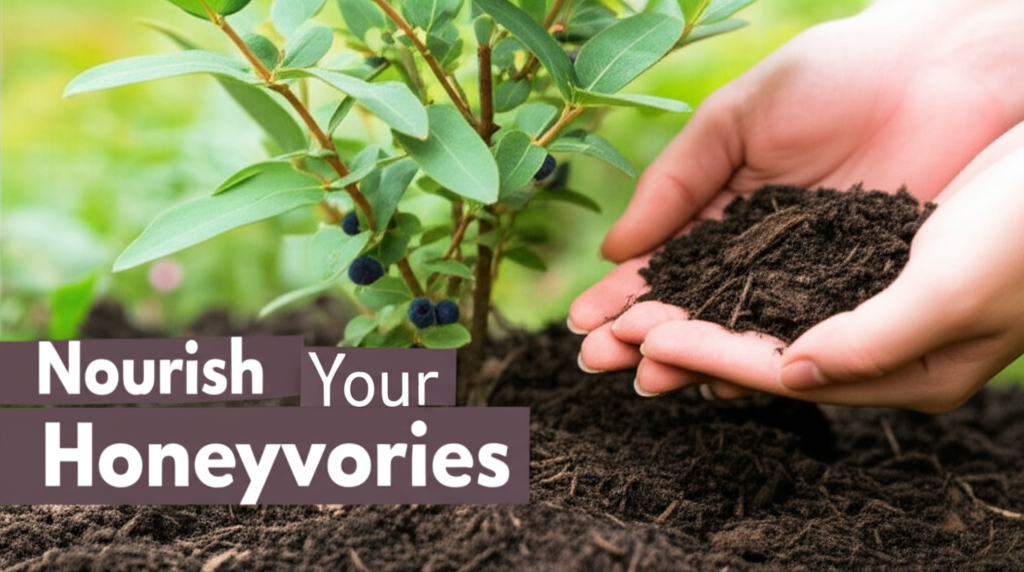Introduction to Honeyberry Fertilization
Honeyberries, also known as Haskaps, are a rewarding addition to any garden. These resilient shrubs offer early-season fruit, often ripening before strawberries, and are packed with antioxidants. To ensure a bountiful harvest of plump, flavorful berries, understanding their nutritional needs and how to meet them with DIY natural fertilizers is crucial. This guide will walk you through the benefits of natural fertilization for honeyberries, essential nutrients they require, and practical, step-by-step methods for applying homemade concoctions. By harnessing the power of organic materials, you can foster healthier plants, improve soil structure, and ultimately, enjoy tastier, more abundant honeyberries.
Why Choose DIY Natural Fertilizers for Honeyberries?

Opting for DIY natural fertilizers offers a sustainable and eco-friendly approach to nurturing your honeyberry bushes. Unlike synthetic fertilizers, which can sometimes lead to soil imbalances and runoff pollution, natural alternatives work with your soil’s ecosystem to provide a slow, steady release of nutrients.
Benefits of Natural Fertilization
- Improved Soil Health: Organic matter enriches the soil, improving its structure, aeration, and water retention. This creates a more hospitable environment for beneficial microbes and earthworms, which are vital for plant growth.
- Slow and Steady Nutrient Release: Natural fertilizers break down gradually, providing a consistent supply of nutrients to your honeyberries. This reduces the risk of nutrient burn and promotes steady, healthy growth.
- Cost-Effectiveness: Many natural fertilizer ingredients can be sourced from your own kitchen scraps, garden waste, or readily available household items, significantly reducing gardening costs.
- Environmental Friendliness: By utilizing compostable materials and avoiding synthetic chemicals, you contribute to a healthier environment and reduce your garden’s ecological footprint.
- Enhanced Flavor and Nutritional Value: Well-nourished plants often produce fruits with superior flavor and a higher concentration of beneficial compounds.
Understanding Honeyberry Nutritional Needs
Honeyberries are not overly demanding plants, but like all fruit-bearing shrubs, they benefit from a balanced nutrient profile. The key macronutrients they require are nitrogen (N), phosphorus (P), and potassium (K), along with essential micronutrients.
Key Nutrients for Honeyberries
- Nitrogen (N): Crucial for leafy growth, stem development, and overall plant vigor. Too little nitrogen can result in stunted growth and pale leaves, while too much can lead to excessive leafy growth at the expense of fruit production.
- Phosphorus (P): Essential for root development, flowering, and fruit set. Adequate phosphorus promotes strong root systems, which are vital for nutrient and water uptake.
- Potassium (K): Plays a role in overall plant health, disease resistance, and fruit quality, including sugar content and flavor.
Micronutrients
While needed in smaller quantities, micronutrients such as calcium (Ca), magnesium (Mg), sulfur (S), iron (Fe), manganese (Mn), zinc (Zn), copper (Cu), boron (B), and molybdenum (Mo) are equally important for healthy honeyberry growth and fruit production. Many natural fertilizers provide a broad spectrum of these essential micronutrients.
DIY Natural Fertilizer Recipes and Applications
Creating your own fertilizers is a rewarding process. Here are some effective recipes using common household and garden materials, along with guidance on how and when to apply them.
1. Compost Tea: The Liquid Gold
Compost tea is a nutrient-rich liquid fertilizer that provides a readily available source of nutrients and beneficial microbes to your honeyberry plants.
Ingredients:
- 1-2 cups mature compost
- 5 gallons water (non-chlorinated if possible)
- Optional: 1 tablespoon unsulfured molasses
Instructions:
- Place the compost in a porous bag (like a burlap sack or old pillowcase).
- Submerge the bag in a 5-gallon bucket of water.
- For aerated compost tea, use an aquarium pump to bubble air through the mixture for 24-48 hours. For non-aerated, simply let it steep for a few days, stirring occasionally.
- Add molasses (if using) during the last few hours of brewing for aerated tea to feed the microbes.
- Strain the liquid to remove any solids.
Application:
Water your honeyberry plants with the compost tea around their base. It can also be used as a foliar spray to provide a quick nutrient boost, though it’s generally more effective as a soil drench. Apply every 2-4 weeks during the growing season, especially after flowering and during fruit development.
2. Banana Peel Fertilizer: Potassium Powerhouse
Banana peels are an excellent source of potassium, which is vital for flowering and fruit production.
Ingredients:
- Banana peels (from ripe bananas)
- Water
Instructions:
- Method 1: Dried and Powdered: Dry banana peels in the sun or a low oven until brittle. Grind them into a powder using a blender or food processor.
- Method 2: Banana Peel Tea: Soak banana peels in water for a few days.
Application:
- Powdered: Sprinkle the dried banana peel powder directly around the base of your honeyberry bushes, gently working it into the top inch of soil.
- Tea: Use the banana peel soaking water as a fertilizer, watering the plants around their base.
Apply monthly from early spring through the fruiting season.
3. Coffee Grounds: Nitrogen Boost and Soil Amendment
Used coffee grounds are a good source of nitrogen, as well as other micronutrients. They also help to acidify the soil slightly, which honeyberries generally appreciate.
Instructions:
Allow coffee grounds to dry completely to prevent mold.
Application:
Sprinkle dried coffee grounds sparingly around the base of your honeyberry plants, keeping them a few inches away from the main stem. You can also incorporate them into your compost bin. Apply every 4-6 weeks during the growing season.
4. Eggshells: Calcium Source
Eggshells provide calcium, which is important for cell wall development and can help prevent blossom end rot (though less common in honeyberries than tomatoes).
Instructions:
Thoroughly rinse and dry eggshells. Crush them into a fine powder using a blender or mortar and pestle.
Application:
Sprinkle the eggshell powder around the base of the plants, gently incorporating it into the soil. This works as a slow-release calcium source. Apply in early spring and again in mid-summer.
5. Epsom Salt (Magnesium Sulfate): For Healthy Leaves
Epsom salts provide magnesium and sulfur, which are essential for chlorophyll production and overall plant health.
Instructions:
Dissolve 1-2 tablespoons of Epsom salt in a gallon of water.
Application:
Water your honeyberry plants with the Epsom salt solution around the base. Do this no more than once or twice during the growing season, as excessive magnesium can cause issues. An early spring application is often beneficial.
Key Facts and Comparison of Natural Fertilizers
Understanding the primary benefits and nutrient contributions of each natural fertilizer helps in choosing the most suitable options for your honeyberry bushes at different stages of their growth.
| Fertilizer Type | Primary Nutrients Provided | Benefits for Honeyberries | Application Frequency | Ease of Preparation |
|---|---|---|---|---|
| Compost Tea | Balanced NPK, Micronutrients, Beneficial Microbes | Overall plant health, root development, nutrient uptake, soil conditioning | Every 2-4 weeks | Moderate |
| Banana Peel Fertilizer | Potassium (K), Phosphorus (P), Calcium (Ca) | Promotes flowering and fruiting, improves fruit quality | Monthly | Easy (powdered/tea) |
| Coffee Grounds | Nitrogen (N), Micronutrients | Encourages leafy growth, adds organic matter, slightly acidifies soil | Every 4-6 weeks | Very Easy (dried) |
| Eggshells | Calcium (Ca) | Strengthens cell walls, aids in nutrient absorption | Early spring & mid-summer | Easy (powdered) |
| Epsom Salt | Magnesium (Mg), Sulfur (S) | Boosts chlorophyll production, improves leaf color and vigor | 1-2 times per season | Very Easy (dissolved) |
When and How to Apply Fertilizers to Honeyberries
The timing and method of fertilizer application are as important as the fertilizer itself. Applying the right nutrients at the right time will maximize their effectiveness and support healthy, productive honeyberry plants.
Fertilization Schedule
- Early Spring (Before Bud Break): This is the most crucial time for fertilization. Apply a balanced organic fertilizer (like compost or compost tea) to provide essential nutrients for the upcoming growing season. This is also a good time for a light application of coffee grounds or powdered eggshells.
- Late Spring (After Flowering): As the plants transition from flowering to fruit development, a boost of potassium is beneficial. Banana peel fertilizer or compost tea can be applied at this stage to support fruit set and quality.
- Mid-Summer (After Harvest): After the fruit has been harvested, a light application of compost or compost tea can help the plant recover and prepare for the next growing season. You can also apply powdered eggshells at this time.
- Late Summer/Early Autumn: Avoid heavy fertilization at this time, as it can encourage new growth that may be susceptible to frost damage. A light application of compost is generally safe.
Application Techniques
- Soil Drenching: For liquid fertilizers like compost tea or diluted banana peel water, water the soil around the base of the plant, ensuring the root zone is adequately moistened.
- Top Dressing: For dry fertilizers like powdered eggshells, dried coffee grounds, or compost, spread them evenly around the base of the plant, keeping them a few inches away from the main stem to prevent root burn. Gently scratch them into the top layer of soil.
- Foliar Feeding: While less common for honeyberries, a diluted compost tea can be misted onto the leaves to provide a quick nutrient boost, particularly if plants show signs of deficiency.
Pros and Cons of DIY Natural Fertilizer Application
While DIY natural fertilizers offer numerous advantages, it’s also important to be aware of potential drawbacks or limitations.
| Pros | Cons |
|---|---|
| Eco-friendly and sustainable | Nutrient analysis can be imprecise |
| Cost-effective | Some preparations can be time-consuming |
| Improves soil structure and health | May attract pests if not properly prepared (e.g., uncomposted materials) |
| Slow and steady nutrient release, reducing risk of burn | Nutrient availability can be slower compared to synthetics |
| Reduces reliance on chemical inputs | Requires consistent effort and knowledge of plant needs |
| Can use kitchen and garden waste, reducing landfill | Some materials might have strong odors during preparation |
| Promotes a healthier ecosystem in the soil | Effectiveness can vary based on soil type and climate |
Troubleshooting Common Honeyberry Fertilization Issues
Even with the best intentions, you might encounter some common issues. Here’s how to address them:
Yellowing Leaves (Chlorosis)
- Possible Cause: Nitrogen deficiency, iron deficiency, or improper soil pH.
- Solution: Apply compost or compost tea for a balanced nutrient boost. If you suspect iron deficiency, a foliar spray of diluted Epsom salt (magnesium is often linked with iron uptake) might help. Ensure your soil pH is in the optimal range for honeyberries (slightly acidic, 5.5-6.5).
Stunted Growth
- Possible Cause: Lack of essential nutrients (especially nitrogen and phosphorus), poor soil drainage, or insufficient sunlight.
- Solution: Ensure you are fertilizing regularly with a balanced organic approach. Check that your soil drains well and that the plants are receiving at least 6-8 hours of sunlight per day.
No or Poor Fruit Production
- Possible Cause: Lack of pollination, insufficient phosphorus or potassium, or extreme weather conditions.
- Solution: Ensure you have at least two different varieties of honeyberries planted for cross-pollination. Supplement with potassium-rich fertilizers like banana peel applications during the fruiting season. Protect plants from extreme temperatures if possible.
Conclusion
Nurturing your honeyberry shrubs with DIY natural fertilizers is a fulfilling way to enhance their health, productivity, and the quality of the fruit they produce. By understanding the nutrient needs of these remarkable berries and utilizing readily available organic materials, you can create a sustainable and effective fertilization program. Remember to observe your plants, adjust your approach as needed, and enjoy the delicious rewards of your organic gardening efforts. Happy honeyberry growing!


